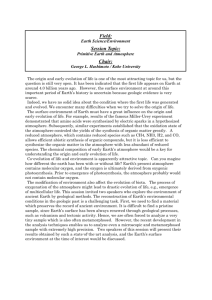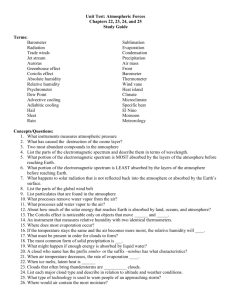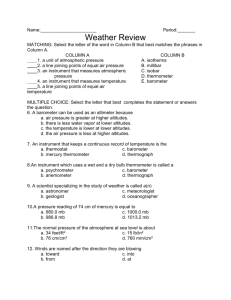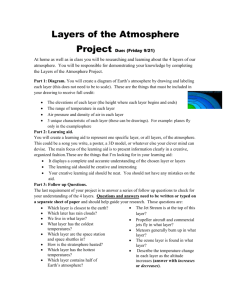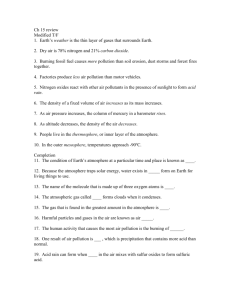Atmosphere
advertisement
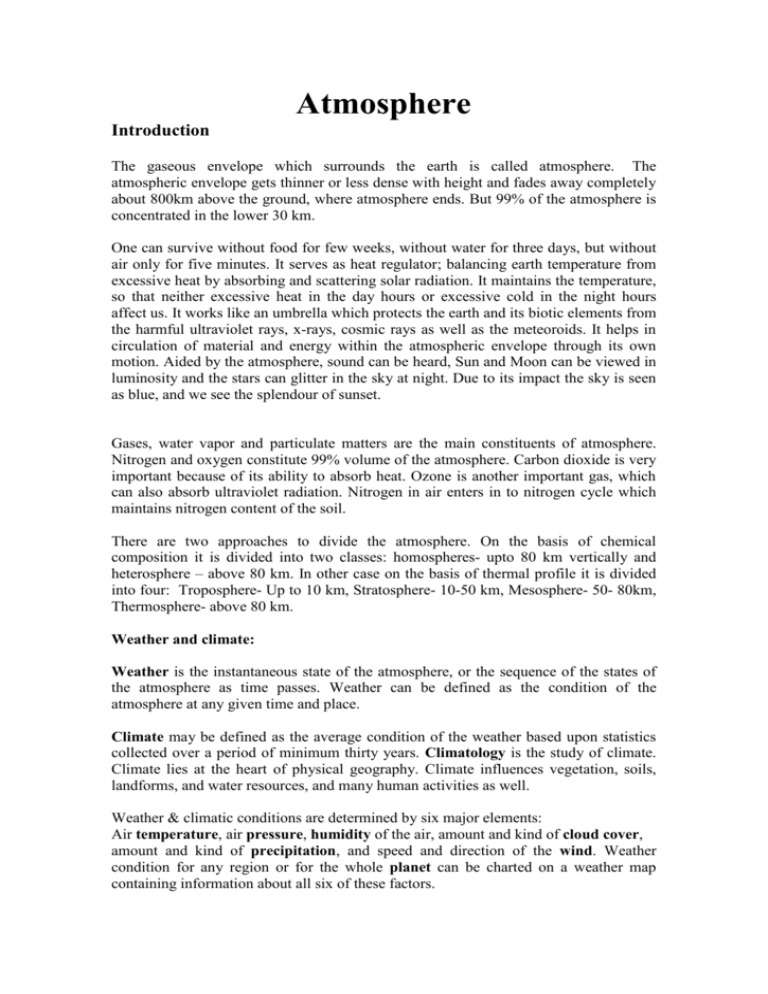
Atmosphere Introduction The gaseous envelope which surrounds the earth is called atmosphere. The atmospheric envelope gets thinner or less dense with height and fades away completely about 800km above the ground, where atmosphere ends. But 99% of the atmosphere is concentrated in the lower 30 km. One can survive without food for few weeks, without water for three days, but without air only for five minutes. It serves as heat regulator; balancing earth temperature from excessive heat by absorbing and scattering solar radiation. It maintains the temperature, so that neither excessive heat in the day hours or excessive cold in the night hours affect us. It works like an umbrella which protects the earth and its biotic elements from the harmful ultraviolet rays, x-rays, cosmic rays as well as the meteoroids. It helps in circulation of material and energy within the atmospheric envelope through its own motion. Aided by the atmosphere, sound can be heard, Sun and Moon can be viewed in luminosity and the stars can glitter in the sky at night. Due to its impact the sky is seen as blue, and we see the splendour of sunset. Gases, water vapor and particulate matters are the main constituents of atmosphere. Nitrogen and oxygen constitute 99% volume of the atmosphere. Carbon dioxide is very important because of its ability to absorb heat. Ozone is another important gas, which can also absorb ultraviolet radiation. Nitrogen in air enters in to nitrogen cycle which maintains nitrogen content of the soil. There are two approaches to divide the atmosphere. On the basis of chemical composition it is divided into two classes: homospheres- upto 80 km vertically and heterosphere – above 80 km. In other case on the basis of thermal profile it is divided into four: Troposphere- Up to 10 km, Stratosphere- 10-50 km, Mesosphere- 50- 80km, Thermosphere- above 80 km. Weather and climate: Weather is the instantaneous state of the atmosphere, or the sequence of the states of the atmosphere as time passes. Weather can be defined as the condition of the atmosphere at any given time and place. Climate may be defined as the average condition of the weather based upon statistics collected over a period of minimum thirty years. Climatology is the study of climate. Climate lies at the heart of physical geography. Climate influences vegetation, soils, landforms, and water resources, and many human activities as well. Weather & climatic conditions are determined by six major elements: Air temperature, air pressure, humidity of the air, amount and kind of cloud cover, amount and kind of precipitation, and speed and direction of the wind. Weather condition for any region or for the whole planet can be charted on a weather map containing information about all six of these factors. The six elements determining weather conditions result from the interaction of four basic physical elements the Sun, the earth's atmosphere, the earth itself, and Nature of landforms on the earth's surface. In this context to know about the atmosphere and weather & climate particular, exploring different aspects of weather elements, air pollution and its impact on global climatic scenario of global warming and climate change are very important . Carbon and Climate Change Carbon is an important component cycling in atmosphere, terrestrial and oceanic systems of the earth. Carbon dioxide released by the respiration of all living organisms is taken up by plants in the process of photosynthesis, in which the carbon is fixed as organic matter and the oxygen is released back into the atmosphere. When carbon in losses respiratory and non-respiratory processes are taken into account in terrestrial biosphere, including fires, harvests/removals, erosion and export of dissolved organic carbon by rivers to the oceans, the rest of the accumulated carbon goes for long-term (decadal) storage. Thus carbon moves in complex chemical and physical transfers from sources, or reservoirs, where carbon is released, to sinks, where carbon is taken up. Earth's atmosphere, ocean, land, and living things can be both sources and sinks of carbon. In Earth's atmosphere, CO2 is only about 0.03% by volume, but it is an important "greenhouse" gas. It traps in the lower atmosphere much of the heat radiated from the Earth's surface thereby maintaining the earth’s radiation budget. However concentrations of CO2 have been constantly increasing due to CO2 emissions from burning of fossil fuel, deforestation and large scale disturbance of land for urbanization. Due to increasing CO2 concentrations, the global average surface temperature (the average of near surface air temperature over land, and sea surface temperature) has increased since 19 th century. Over the 20th century the increase has been 0.6 ± 0.2°C. India also witnessed a warming trend at a rate 0.6°C per century. In the state of Andhra Pradesh temperatures even rose to 48.9°C during May 2002, resulting in the highest one-week death toll on record. A number of environmental catastrophes have been consequently triggered as result of the climate variability. The initial impacts are tangible across the world including the decrease of artic ice caps and disappearance of several vulnerable species. Current research across the world is targeted over potential carbon sequestration mechanism to mitigate this climate change caused by CO2 rise. Not only that in may cases it is link with local condition also like temperature inversion. Project 1. Monitoring weather though mini weather station: Monitoring weather is most pivotal in all studies on earth. Children may develop their own low cost weather station in the school and monitor weather. Objective: To measure different parameters of weather by the children in connection with different projects. Materials required: One ordinary alcohol thermometer, one funnel, one measuring cylinder, one convex lens, one ordinary scale (ordinary geometry box scale), two rubber balls, bamboo/wood/plastic stick Methods: 1. The alcohol thermometer can be used for measuring the temperature at any moment. The children can take the reading at different intervals of time and keep record to have a temperature profile of any place. 2. The same thermometer can be used for measurement of the relative humidity by making the thermometer as a wet bulb thermometer by putting a small piece of wick or thin cotton cloth over the thermometer bulb after soaking in water (just soak the piece of cloth in water and put around the thermometer bulb and take the reading after 4-5 minutes). From the reading of dry bulb thermometer (without applying wick or wet cloth) and the wet bulb thermometer, the relative humidity can be calculated by using standard chart or the formula given in the text book. 3. A rain gauge can be prepared by putting a funnel over a measuring cylinder. Rain drops falling on the funnel will be collected in the cylinder. Measure the area of the funnel and calculate the rain per unit area in that place during a particular period. 4. With the help of a convex lens try to make a burn spot on a piece of paper, note the time required for development of the spot and the distance of the lens from the paper (this is the focal length of the lens) on any sunny day. Take burn spots on similar paper at different time placing the lens over the paper at the same distance for same time, the size of the burn spot will give indirect measure of intensity of sunshine. 5. Make a wind measuring instrument by two balls into halves fixing them at the end of a cross made of bamboo/wood/plastic stick and make a suitable device for free rotation of the cross. By noting the rotations per unit time, the wind speed can be measured. 6. Make a cloud chart as given in Annexure – 1, make one copy on transparent sheet and a number of copies on white paper. Look at the sky at a particular angle in a particular direction from a particular place and note the cloud position in the chart. Application: The measurements of different parameters of the weather, one can undertake few projects like I. Study the correlation among different parameters of weather (temperature, relative humidity, intensity of sunshine, air flow etc.) from the data obtained in the mini weather monitoring station and also with the secondary data collected from weather station, weather report from newspaper / Radio / TV, compare the predicted and actual weather conditions. II. III. IV. Study the general weather parameters in different places (for example forest area, agricultural field, industrial area, urban residential area etc.) and try to correlate the weather conditions with the surrounding conditions. Study the changes in behaviour / reactions of plants and animals (including human) with changes in different parameters of the weather (temperature / relative humidity / sunshine / rain fall etc.). Study the changes of weather pattern of a particular place over a period of time (with the help of secondary data obtained from a dependable source) and the changes in physical environment of the area and also its impact on agricultural and other practices in the area. Project 2. Study of the seasonal variation weather parameters and its association with local agricultural practices Introduction The variation of weather situation in different time frame is basically called as the seasonality. This seasonality has lots of association with agricultural practices, because weather situation of an area basically determines the different situation of land, soil and water parameters required for such practices. These sets of information can provide us problems and prospects of an area from the agricultural perspectives in relation to weather. Objectives: To study the seasonal variability of weather parameters and farmers responses to it designing the agricultural practices of the area. Methodology: Data base: Weather elements: The secondary weather data can be collected from the different sources (as mentioned in project -1. ) For primary data can collected on the basis of tips mentioned in the project 1. Agriculture practice related information: For such purpose one may adopt method of social surveying on the basis of interviewing techniques, For such purpose a pre-designed schedule of question is necessary, where question must be short and specific, Such information can be collected from the local people who have the experience of agricultural practices, like elderly farmers of the village, etc. Compilation of data: The collected data can be compiled in two separate table one is for the weather related information and other is for agricultural practice related information. Now try to draw seasonality relation (as in table given below) incorporating both the information. Conclusion: Try to correlate the association between weather situation and agricultural activity, Identify pattern of change in weather situation and its impact on agricultural activity. Project 3. Study of the pattern of monsoonal rainfall: Monsoon is always in reference to the seasonally shifting winds in the Indian Ocean and surrounding regions, including the Arabian Sea. These winds blow from the southwest during one half of the year and from the northeast during the other. There are seasonal changes which are particularly noticed as northeast winds prevailing in the winter in the Southeast Asia and southwest winds in the summer. The Asian monsoon, which affects the Indian subcontinent and southeast part of the Asia, is probably the most noted of the monsoons. Recent changes of weather and particularly phenomenon of El Nino or La Nina may have impact on rainfall regime in the monsoon period. Therefore study of the rainfall pattern of an area during the monsoon season may help us to understand the rainfall regime and changing scenario in a better way. Objectives: To study the rainfall pattern of an area in the monsoon season. Methodology: Collect the secondary data of rainfall of the study area at least for last 10 to 15 years (more numbers of years provide better information). Now try to find out the trend against taking monthly averages, number of rainy days per months, etc. Interpret your analysis and find out anomalies if any. Project 4. Estimation of carbon stock by herbs and grass in school campus or in residential locations. Carbon dioxide from the atmosphere is fixed by plants in the process of photosynthesis and converted to carbohydrates. This is called Gross Primary Productivity (GPP), which is carbon assimilation by photosynthesis ignoring photorespiration. Terrestrial GPP has been estimated to be 120 Giga ton Carbon /year (Giga is 109). Annual plant growth is the difference between photosynthesis and autotrophic respiration (Ra), and is referred to as net primary production (NPP). NPP is the fraction of GPP resulting in plant growth, and can be measured through sequential harvesting or by measuring plant biomass, provided turnover of all components (e.g., fine roots) is included. Global terrestrial NPP has been estimated to be 60 Giga ton C/yr, that is, about half of GPP is incorporated in new plant tissue. The other half is returned to the atmospheric as CO2 by autotrophic respiration, that is, respiration by plant tissues. Thus Plant biomasses sequester carbon produced due to human activities by the process of photosynthesis. Hence estimation of plant biomass will quantify the amount of carbon sequestered by the plant in a given area. Objectives To estimate the density of herbs (grass, weeds and other small plants) in a given plot of desired size. To estimate the plant biomass in the given plot To find out the available carbon stock in the biomass of the plant Materials requirement Data sheets, measuring tape, rope, poles, collection bag, balance for weighing Methodology 1. 2. 3. 4. Select the area 1 square kilometer or 500 meter square Lay quadrats of 5m X 5m or 2m X2m in different types vegetation Identify and number the plants in the quadrats Harvest the plants 5. Dry the plants in sunlight 6. Find out weight of the dried plant 7. Uses the appropriate equation to quantify carbon stock in the plant biomass. Conclusion: On the basis of your observation try to find out some plant species ideal as carbon sink. Project 5 Study of the impact of Climate Change on spatial and temporal variation on vegetation With the increase in the carbon and aerosol concentration in the atmosphere there has been considerable increase in the global temperature resulting to global climatic change. In order to understand the impacts of this warming and global climatic change on different species and their interrelationship the spatial and temporal variation in and around the school or the other nearby locality could be taken up. Methodology Collect the Survey of India Topographical map [on 1:50,000 scale]of the study area Collect meteorological data on temperature and rainfall of the study Extract contours and few landmark/places. If necessary the map can be zoomed Collect the literature and undertake questionnaire from the elderly farmers about the type of vegetation and agricultural crop grown in different location/altitudinal zones. Prepare maps with respect to the literature or questionnaire from the farmers. Undertake field visits, observe the type and species grown and different altitudes, prepare a map Compare and note the changes This approach may be adopted the see any changes or the transgression of species in non traditional areas to relate with the climate change. Conclude the findings. Project 6. Damage estimation of crops due to frost effects: In the high altitudinal area there are ample amount of forts development due to low temperature. This phenomenon to large extent exerts impacts on crop. It is possible to observe the impact in different situation in relation control with an objective to identify ways for alternative approaches to reduce the damage. Methodology Identify a crop or vegetable species usually grown in the period of your study, which may also, required comparatively short duration in growth. Now plan it in two different locations, one is in open air situation and another is in indoor situation. Now observe the growth pattern along with other phonological aspects daily and record it. In such case one can collect the information like height, Garth, number of leafs, flowers (if any) etc. along with assessment damage in different parts( like number of leaf damage, leaf area damage, etc.). Compare the collected information in both the situation (open air and in door), try assess the probable reason behind the situation. On the basis of this observation try to identify some alternative approaches to over come the situation and make some trial with that. Significance: It may helps to understand magnitude of damage due to such weather condition and help to identify some alternative way to over come the damage. Project 7. Economic analysis of climatic change on agriculture Introduction Indian economy is highly depends on agriculture and associated sector. There is a direct relationship existing between the country’s economy and its climate. A drastic change in climatic pattern is one of the major reasons for the production loss. Since many of the rural population is still depends on agriculture, an economic evaluation of the agriculture yield with the climatic condition of an area will give a clear cut idea about the present status of cultivation. This in turn accounts for the need of change in cropping pattern and change in varieties. Objectives To evaluate the relation ship between climatic condition and agriculture. To suggest appropriate cropping pattern and variety for a local climatic condition. Methods Find your nearest agriculture area A questionnaire survey has to be conducted with farmers and agriculturists to evaluate the annual production rate, status of cultivation etc Data from village offices, Krishibhavans and farmer’s co operative societies has to be collected and total annual production rate evaluated for more than two years. Meteorological data has to be collected from the nearest meteorological station for the same period. A comparative economic analysis will be done between rate of production and the variation in climate. Find out the trend between the climate change and agriculture production rate. Give alternative cropping pattern and varieties which will cop with the condition. Project 8. Study on Traditional calendar system, agricultural cycle and weather conditions. Many tribal and other ethnic groups of India have their own calendar system (like among the Nishis of Arunachal Pradesh and Dimasa of Assam). This calendar is designed with the seasonal variation of different weather elements as well as time plan for agricultural activities. Therefore study of such calendar systems in relation to weather elements can reveals different aspects impact of seasonality on agricultural activities. Objectives: To study the traditional calendar systems of the indigenous ethnic groups and find out its relevance with pattern of weather elements along with the agricultural activities. Methodology: Collect the information of traditional calendar system through interview with village elders, priest, and other persons who have knowledge about the particular groups. Consultation of literature on that group of people to know about background of such practices. Collection of secondary information on weather elements from reliable sources. Collection information on general people knowledge about the calendars and its uses through survey. Correlate the weather elements distribution pattern on English calendar and traditional calendar and find out the relevance with agricultural practices. Conclusion: Draw conclusion on the aspects of relevance of such calendar systems in agricultural planning. Project 8. Observation of thunderstorm and assessing its impact on human activity A thunderstorm is a local storm, invariably produced by cumulonimbus clouds, that always is accompanied by lightning and thunder. Severe Thunderstorms, commonly known as Bordoloichila in Assamese, or Kalbaisakhi in Bengali, are results of outburst of severe local convective clouds and are a common feature of the weather in the pre-monsoon season (March to May) in the eastern and north-eastern part of our country. From this perspectives children can undertakes some project in the area of prerequisite condition for occurrences of the phenomenon, pattern in occurrences by observing variation of lighting and sound and assessing the damage due to it along with level of awareness on it. Objective: To understand the situation where such phenomenon occurs, what is spread in the locality and extends of damage due to it. Methodology: Collecting information on humidity and temperature of the period of occurrences, along with observation of clouds. Observation and recording of the timing of lighting and thunder (sounds), estimating distances upon it. Preparing a possible area of influence on the basis above information taking only aerial distances. Identification of area of damage and assessing the magnitude of damage on the basis of impact survey using schedule of question for interview and observation sheets. Interpretation: Correlate all the collected information with the phenomenon and try to find out some clue make strategy for mitigation. Project 9. Hazard damage mapping Introduction Hazards are extreme situation, makes threats to life and property. Threats to livelihood. Disaster is a potential risk to these events. Impact of disaster phenomenon is the product of Hazards and Vulnerability. It can be expressed as, Risk = Hazards (Vulnerability – Capital/Capacity) Where, Hazards = ∑ TH, MH Vulnerability =∑ SNC, SPC, SFC, SSC, SHC ( TH – Type of hazards, MH- Magnitude of Hazards, SNC – Status Natural Capital, SPC – Status Physical Capital, SFC – Status of Financial Capital, SSC- Status Social Capital , SHC – Status of Human Capital) Natural Hazard: When it is occurs due to natural phenomenon/forces is called as Natural Hazard. Therefore from these perspectives it is very much essential to make an assessment of damage of such phenomenon. Objectives: To identify the area of damage and plot it in the local map. In case of map one can use cadastral map or municipal area ward map or topographical map with adequate enlargements. Conduct damage assessment survey in the area covering different aspects of damage, like damage of housing, cropping area and crops, household infrastructure/ gadgets, lost of animal, lost human life, damage to human body, displacement of human being, lost of occupation, lost public property like schools, well, road, electricity transmission line etc. Try to quantify the damage on the basis of quantum and magnitude of damage. Try to make grading scale and put some score for it and sum up with total score and transferred the information to map. Interpretation: Interpret the spatial pattern and make some strategy of mitigation on the basis of information already collected. Project 10. Assessment of air quality Introduction Assessing air quality is a basic requirement for assessing the extent of air pollution in a particular area. There are standard methods for determination of air qualities or extent of air pollution and there are many recognized laboratories where such analysis is being done. But all children cannot have access to those laboratories. Instead of going to standard laboratories where measurements are done by costly equipments, children can develop some innovative method for assessing the air quality where by they can understand many more things. 1. Content of sulphur di oxide in the air can be assessed by observing lichen in trees (lichens are considered as bio indicator of sulphur di oxide). Comparative picture of sulphur di oxide content in air in different places can be developed by studying lichens in similar trees in those places. 2. Content of Sulphur di oxide also affects the physical property of rubber. So by observing the physical quality of a stretched rubber band (not polymer bands) in different places a comparative picture of sulphur di oxide content can be drawn. 3. Content of carbon di oxide in air can be estimated (qualitatively) by using lime water and a pneumatic pump (aquarium air pump will do). One can take some quantity of clear lime water in a test tube and pass air in that by using a pneumatic pump for some time, the lime water will become milky. By comparing the milkyness developed in different places (an industrial area, bus stand, forest, residential area etc.) by passing air for same time a comparative picture of carbon di oxide content can be drawn. 4. A simple instrument for measuring suspended particles in air can be made by using a pneumatic pump. Put a pneumatic pump in a plastic box as shown in the figure given below. Arrangement should be made for fixing a nylon cloth under cap so that when the pump is operated, air is sucked through the nylon cloth and pass out through the air outlet. The increase in weight of the nylon cloth before and after running the pump (for few hours) will give a measure of suspended particles in the air. Project 11 Study of impact of the weather condition on animal: Introduction ‘Summer-sterility’ is a very common finding in buffaloes. The heat affects the hormonal profile causing increase in the stress level. These levels in turn suppress the fertility in buffaloes, and they go sterile during hot summer months. Similarly, high levels of humidity present in the poultry farms affect respiratory system and this in turn causes drop in egg production. Objective To study the effect of weather parameters on the production profile of domestic animals: A. To study the effect of weather changes on milk production: B. To study the effect of changes in weather and / or farm conditions on egg production / live weight gain: Methodology: 1. Visit to the farms (dairy / poultry, as the case may be) at least 10 in number. 2. Collect information on breeds (pure exotic / crossbreed / indigenous in case of cattle) and buffaloes, and poultry. 3. Find out the number of animals and their age groups. 4. Identify the test group by way of knowing number of animals in production and from the same age group. (Each group should have the animals from more or less same age group so as to avoid any error on that ground). 5. Collect information on feed and water consumption per day. 6. Record production of milk (in liters), eggs (in number), and live weight gain (in grams) per day. 7. At the same time observe and record daily temperatures and relative humidity. 8. In general, the recordings of these observations are to be made for nothing less than a period of one month. 9. Tabulate the results under weather and production parameters. The same can also be shown in graphical representation. 10. Conclusion and inference would be based on the correlation established from the data analyzed.


